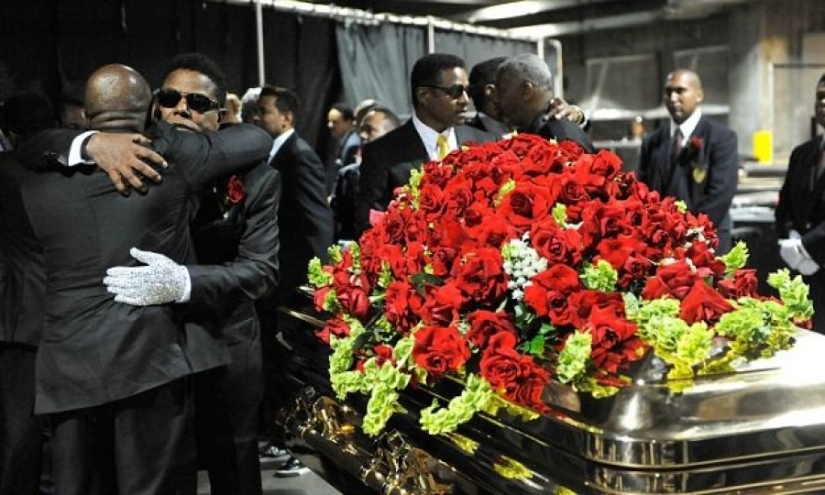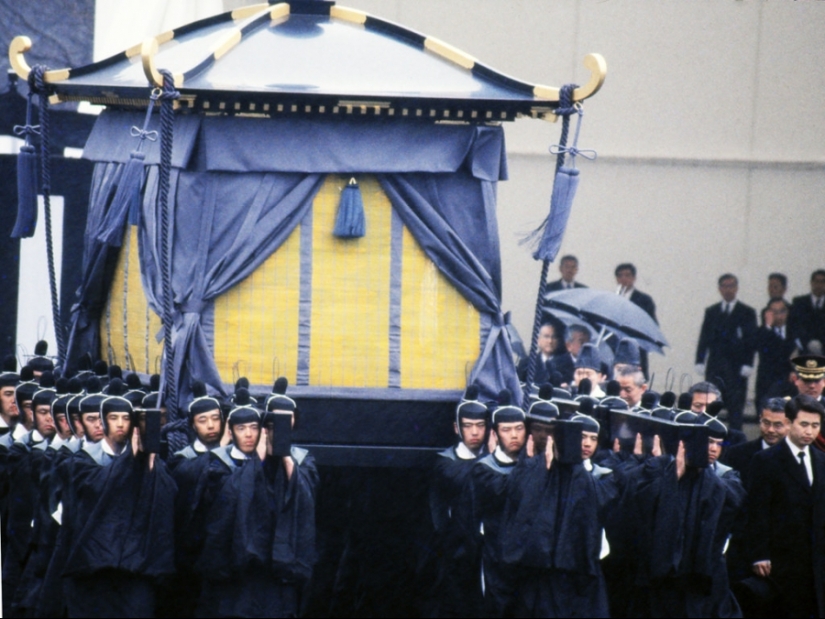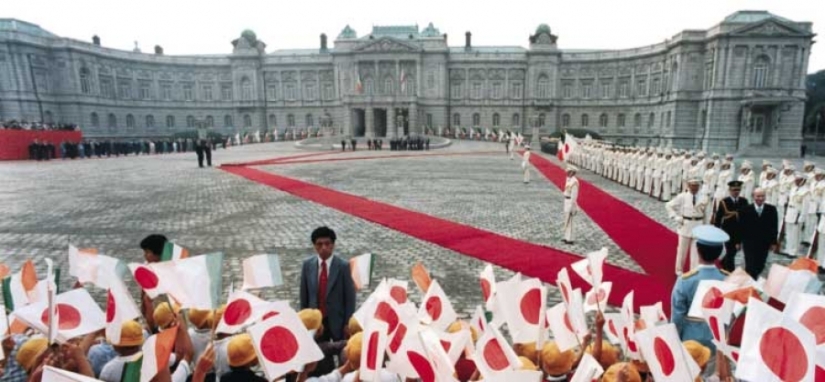How the most expensive and magnificent funerals of famous people in history took place
Categories: Celebrities | History
By Pictolic https://pictolic.com/article/how-the-most-expensive-and-magnificent-funerals-of-famous-people-in-history-took-place.htmlOn November 15, 1982, the funeral of Leonid Ilyich Brezhnev took place on Red Square. As at the farewell to his predecessors, thousands of citizens joined the magnificent procession. Funerals are an integral part of life, and since many celebrities and politicians live large lives, they are sent off accordingly.


Leonid Brezhnev, who died on November 10, 1982, like other Soviet general secretaries, was buried with special pomp, although the cost of such a procession is not known for certain.

The whole ceremony was furnished extremely magnificently, but was not without some incidents. As a rule, during the funerals of Soviet leaders, it was customary to carry velvet pillows with orders and medals behind the coffin with the body of the deceased, and this responsibility was assigned only to senior officers.

Each officer carried a small pillow with one order. Brezhnev had more than two hundred of them. It was necessary to combine some awards, and the honorary officer escort amounted to 44 people.

For three days, the body of the Secretary General was exhibited in the Hall of Columns of the House of Unions, where several hundred thousand people visited him. Brezhnev was buried at the Kremlin wall, and at that moment all enterprises and organizations in the country stopped their work for five minutes, which in total also cost a lot of money.

Michael Jackson was a true king of pop music, and his death, like his life, was shrouded in loud scandals: the singer died in 2009 from an overdose of propofol, for which his personal doctor was to blame.

Jackson was buried only two months after his death in the “Great Mausoleum” of Hollywood Forest Lawn Cemetery. Among the guests were only relatives and close friends of the singer, but several hundred journalists received accreditation, and millions of Americans watched the ceremony live.

Broadcasting was permitted only until the moment when the gilded coffin with the body arrived in a hearse. Then for some time the ceremony was shown from helicopter cameras, but soon this was interrupted.

After the King of Pop was buried in a huge chapel, those invited went to a memorial dinner at an Italian restaurant.

The artist's coffin, named "Prometheus", was made of bronze and covered with 14-karat gold plating, and the inside was lined with bright blue corduroy fabric. This product cost 25 thousand dollars.

The whole ceremony, although it took an hour and a half, cost the singer’s relatives an amount close to a million dollars.

James Brown, the godfather of soul, died at the age of 73 from a heart attack due to pneumonia. The funeral of a lover of chic and glitz was arranged accordingly.

Farewell to him took place at New York's Apollo Theater in Harlem. His coffin was almost the same as Michael Jackson's, and accordingly, its price was exorbitant.

The funeral of Elvis Presley, another “king,” this time of rock and roll, in 1977 cost $23,789 (more than one hundred thousand in today’s exchange rates).

When news of the singer's death appeared in the newspapers, 25,000 fans surrounded his Memphis estate in two days.

The relatives paid for the magnificent ceremony at the expense of the deceased himself, and some even managed to earn a tidy sum. The funeral itself was closed to the press, but one of Presley's cousins sold a photo of the singer's body in a coffin for $18,000. And the magazine with the photo on the cover sold 6.5 million copies.

Margaret Thatcher, or the Iron Lady, was British Prime Minister from 1979 to 1990 and died in April 2013 from a stroke.

$1.8 million was spent on the politician's funeral. Moreover, a fabulous amount was taken not only from Margaret Thatcher’s property, but also from citizens’ taxes.

At the same time, only $400 thousand was spent on the ceremony itself at St. Paul's Cathedral, and the rest of the amount went to ensure security at the funeral.

Another $31,000 went to the London Ambulance Service. It is not surprising that numerous protests arose among citizens, because not everyone was happy with Thatcher’s policies, and therefore not everyone was happy with the spending of money from the budget.

Sir Winston Churchill, British Prime Minister, writer, Nobel Prize winner in literature and honorary citizen of the United States, was buried with even greater pomp.

Because Churchill played a major role in ending World War II, his funeral in 1965 was a ceremony reserved only for members of the royal family.

In 1965, 258 thousand dollars were spent on organizing the politician’s funeral, which by today’s standards corresponds to 4.2 million.

Princess Diana, wife of Prince Charles of Wales and beloved by the British and people around the world, died in 1997 in a car accident in Paris. They spent $7.7 million on the lavish funeral (11.8 million today).

It is unknown what, but clearly quite large sums of money were spent by ordinary citizens: from September 1 to 8, 5 million bouquets of flowers weighing from 10 to 15 thousand tons were laid at Buckingham Palace, St. James's Palace and Kensington Palace in memory of Diana.

On September 6, more than a million people witnessed the funeral procession, and the bell of Westminster Abbey chimed every minute as Diana's coffin was transported on a ceremonial cannon carriage.

Pope John Paul II, the leader of the Catholic Church, headed it from 1978 to 2005, until his death. He was seen off on his final journey with pomp.

The funeral of John Paul II cost organizers $11.9 million. As with Thatcher, the biggest expense was security, as four kings, five queens and 70 presidents attended the ceremony.

Elizabeth II died on September 8, 2022 at the age of 96; her funeral took place on September 19. National mourning lasted ten days, during which time hundreds of thousands of people visited the Palace of Westminster, where the queen's coffin was on display.

The Queen was buried in St George's Chapel on the grounds of Windsor Castle. The Queen's father and mother, George VI and Elizabeth Bowes-Lyon, and her sister Margaret are buried in the George VI Chapel. The body of her husband, Duke of Edinburgh Philip, was also transferred there. Thus, the couple, who had lived together for 73 years, were reunited after death.

The funeral ceremony took place in the presence of those closest to him, but the memorial service was attended by more than two thousand people. Among them are more than a hundred heads of state. The funeral of the longest-reigning queen and mourning events throughout the UK cost the country's budget about £162 million (approximately $201 million). The largest expenses were incurred by the Ministry of Internal Affairs and the Ministry of Digital Technologies, Culture, Media and Sports.

John Kennedy, one of the most beloved presidents in US history, was assassinated in 1963. The burial site was chosen at Arlington National Cemetery, which cost $13 million.

About 800 thousand people lined the streets along the route of the procession to say goodbye to the president. A Mass followed at the cathedral, after which the procession headed to Arlington National Cemetery.

The coffin with the body of the president was moved on a cannon carriage, in front of which a black stallion was led. When the coffin was lowered into the ground, Kennedy's widow lit an eternal flame on the grave.

The entire ceremony was broadcast on three national channels, and the entire cost of the funeral was $15 million.

Kim Jong Il, the supreme leader of North Korea, created a cult of himself during his lifetime, so his death caused mass hysteria among his circle and the general population.

Thus, a statue of Kim Jong Il was erected worth 10 million dollars.

Since it was decided to embalm the Secretary General, Russian specialists were brought in. Their work and the special sarcophagus cost, according to media reports, a million dollars.

Ronald Reagan, former Hollywood actor and US President from 1980 to 1988, died in 2004. The funeral ceremony cost the organizers $400 million.

In addition, the US stock market had to be closed for a day due to prolonged mourning, which led to huge financial losses.

The funeral of Japanese Emperor Hirohito took place in 1989 and at that time cost $76.4 million ($139.3 million at current exchange rates).

By the way, the cost of even an average funeral in Japan most often exceeds 20 thousand dollars, so it is not surprising that farewells to top officials of the state cost fabulous sums.

The emperor's funeral cortege consisted of 70 cars. They, along with escort services, spent $24 million.

Another $22 million was spent on the construction of a pavilion in Shinzyuku Gehen Park for funeral rites over Hirohito's body, which were attended by 225 people.

Secretary General Joseph Stalin died of a cerebral hemorrhage on March 5, 1953 at 21:50, and the next day the leader’s body was exhibited in the Hall of Columns of the House of Unions for a three-day farewell.

More than two million people took part in the procession, and up to two thousand people died in the stampede on Trubnaya Square. On March 9, Stalin's embalmed body was placed in the Mausoleum.

The most expensive funeral in history, according to historical books, was arranged for Alexander the Great. According to some reports, their value today would be more than $600 million.

A sarcophagus made of pure gold, a golden chariot and a new road specially built from Persia to Egypt are just a few of the expenses for seeing off the great emperor-commander on his last journey.
Recent articles

A couple of years ago, Saudi Arabia officially banned celebrating the New Year. But this state is far from the only one where our ...

What do you associate the New year? Tangerines, chime, silver rain on the tree, gifts from Santa Claus and snow Maiden, and of ...

This is for us, people, the New Year is one of the most important holidays of the year. But for animals, it's all a fuss, running ...